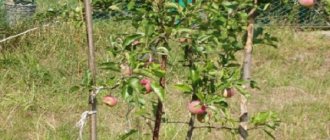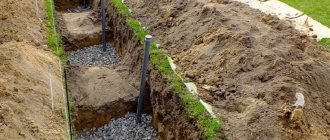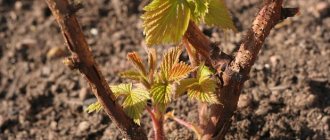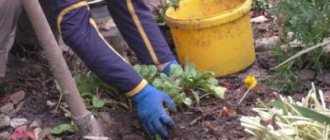Gardening » Apple tree
0
279
Article rating
Kira Stoletova
Often gardeners are forced to replant apple trees to another location. There are many reasons: crown growth, unfavorable location, deep root collar, sending the seedling for sale. Let's consider how to carry out the procedure in the fall, and what deadlines should be followed?
Autumn apple tree transplantation - when to carry out the procedure
Features of transplanting an apple tree to a new place in the fall
In order for the transplant to be successful, the choice of the time of year suitable for this operation and many other details are important.
In case of serious violations of the basic rules of replanting, the tree may poorly take root in a new place, may not bear fruit for a long time, become sick and even die.
By the time of transplantation, the tree must enter a period of half-sleep, shed its leaves, and its wood must ripen. An unfinished tree is virtually doomed to death in the coming winter cold.
It is also important to have a hole prepared in advance for replanting and optimal depth when replanting the tree itself, taking into account the correct location of the root collar.
All these mistakes subsequently lead to poor survival and suppressed tree growth.
When to replant an apple tree in the fall (in what months)?
Having decided to replant an apple tree, the gardener must take into account a number of important factors . It is important to choose the time when you can replant the apple tree in the fall.
The tree needs to be replanted, not too early, but not too late. It is usually recommended to carry out such a transplant from the end of September to mid-October.
The leaves of the apple tree should have fallen by this time, and older trees should have shed their fruit . That is, a period of half-sleep must begin. The life processes of the tree slow down, but the roots still retain a certain activity.
The apple tree will be capable of restoring tender fibrous roots as long as the air temperature is above +4 degrees C.
Autumn replanting allows the tree to take advantage of the not yet cold soil and, to a certain extent, adapt to new conditions and even grow fibrous roots, which are extremely important in the process of absorbing nutrients and water from the soil.
But it is not advisable to delay replanting in the fall . It is necessary to complete this process 2-3 weeks before the onset of frost, but better - a month before them. Otherwise, it will be difficult for the tree to survive the cold period.
But if the transplant is completed at a favorable time, then the apple tree will have time to harden during the cold period.
Fibrous roots are restored to a temperature of +4 degrees Celsius.
IMPORTANT! A situation may arise when you have to replant a tree with leaves. Then it is recommended to trim the leaves on the tree, and choose a foggy day for replanting, and the time of day - evening. By evening, the processes of photosynthesis and intense evaporation of water are completed.
Technologies for transplanting young and old apple trees
It is better to choose a place where the apple tree will grow on some elevation, illuminated by the sun, not blown by the winds. Apple trees do not like stagnant water and drafts.
The soil, if possible, should be light and fertile, and if deep water is nearby, drainage is necessary. Broken brick, stones, and crushed stone are suitable for it.
Technologies for transplanting young and old apple trees differ from each other.
But this process must begin by preparing a hole for the tree.
It is advisable to dig it up 2-3 weeks earlier, lay the necessary soil mixture with fertilizers and water it well. During this time, the soil in the pit will settle and settle .
This is important for the further correct positioning of the root collar to avoid its excessive deepening.
Preparing the pit should begin a month before transplantation.
The roots of the apple tree should not touch the edges of the hole , and the hole should be one and a half times larger than the clod of earth.
When digging a hole, it is recommended to put the top layer of soil aside. It is the most fertile and will go deep into the pit, and the lower layer, the poorer one, will be poured on top.
IMPORTANT! For both a young and an adult tree, it is important to maintain the same orientation of the branches to the cardinal points. To do this, paint marks are made on the trunk of the apple tree before digging it up.
The process of transplanting young apple trees 3-4 years old does not present any great difficulties.
It is important to minimally disturb or damage the roots when digging up an apple tree :
- First, several buckets of water are poured under the tree to sufficiently moisten the entire root system and they dig around it in a circle. The distance from the trunk will be approximately up to 70 cm and will be a cone, narrower in depth. The depth of the cone will be approximately equal to the same distance.
- After which the tree is carefully removed without shaking off the soil from the roots .
- It is very important to correctly position the root collar when planting. It should be level with the soil level. To do this, when planting a tree, it is raised by 3-5 centimeters, taking into account future settlement. Perhaps a mistake was made here during the previous landing.
- An apple tree is lowered into a pre-prepared hole with fertilized soil - black soil, peat, compost and mineral additives. If necessary, the roots are straightened.
- The roots are carefully covered with fertile soil so that there are no voids.
- A stake is also driven into the hole , to which an apple tree is tied.
- Then the tree is watered with water in the amount of several buckets: (3-5).
Often there is a need to replant fairly large trees. But there are observations from experienced gardeners who say that the optimal age of an apple tree being prepared for replanting is from 3 to 5 years.
Replanting older trees is more risky.
Interesting ! An option for preparing a mature tree for replanting is described, which consists of cutting off the roots along the intended circle by digging a trench. Next, the tree is allowed to grow small fibrous roots along this perimeter over several warm months. After which the tree is dug up from below and the entire lump is transferred to a new place . Obviously, if the transplant is planned in the fall, this procedure should be done in the spring.
So, replanting old apple trees will have certain differences .
If you are faced with the task of replanting an adult apple tree in the fall, you must:
- Start preparing for replanting by selecting auxiliary materials: garden tools, strong ropes, water, stakes for stretching (at least 3), matting;
- Lay a hole at the selected location, add a mixture of nutritious soil with peat, compost , and the necessary fertilizers;
- Dig a hole one and a half times larger than a clod of earth;
- Make paint marks on the tree trunk for further correct orientation of the apple tree to the cardinal points;
- When digging up an apple tree, try, if possible, to preserve the main rhizomes, as well as a larger lump of earth;
- The earth is not shaken off from the roots;
- Wrap the trunk in cloth , matting, strengthen the lump with boards to avoid damage, and bend large branches to the tree;
- Reduce the time before planting an apple tree;
- When planting, take into account the previous orientation of the tree;
- Place the apple tree in the hole so as not to bury the root collar;
- The roots of the apple tree are covered with fertile soil and attached to stakes using guy wires;
- The tree is watered abundantly.
Transplanting an adult tree together with a lump.
How to replant an apple tree from 1 year to 15 years.
Depending on the age, the process of transplanting an apple tree differs.
At the age of 1 year
In practice, replanting a 1-year-old apple tree in the spring is practically not used. Seedlings that young are not available for sale. A summer resident can only encounter them if he decides to grow an apple tree on his own , which is called from scratch.
If the need to replant an annual plant nevertheless arises and the seedling is dug out of the ground, the root system is injured and branches out.
Such an injury is not only not dangerous, but also beneficial to the young plant . About 10-12 branches appear in a new location, and thin fibrous roots are actively formed. A superficial root system is formed that is capable of well absorbing nutrients from root feeding.
This is good for the gardener because the growth process of the apple tree will be easier to manage.
If the seedling was originally grown in a container, replanting practically does not damage the roots.
Therefore, the main root must be picked at a distance of 20 cm from the root collar in order to stimulate the formation of skeletal horizontal roots.
The transplant process at this age is not difficult. The tree quickly regenerates.
A seedling can only be ruined by a barbaric attitude, in which the root breaks at the very root collar or all the suction roots are destroyed. The latter can happen if you leave a seedling with bare roots in the scorching sun or leave it in water for a month.
Important! Autumn replanting of 1-year-old apple trees is usually required for those who grow planting material for themselves or for sale.
The process involves transferring the young rootstock from the school for further grafting.
The seedling is dug up at the end of September - beginning of October.
In a young tree, the tap root should be cut to a third of its length. This procedure will allow the formation of a wide system of suction roots.
Leaves are removed.
Until spring, the rootstocks should be removed to a cool room. The root system must be protected from drying out and excessive moisture. This can be done by covering the roots with sawdust and wrapping them in film.
Rootstocks are planted in a permanent place or in seed beds in early spring. When the seedling takes root, grafting is carried out . Under good conditions, this can be done in the fall; in other cases, the vaccination can be postponed until next spring.
During the normal transplant procedure:
- Prepare the hole
- Carefully dig up the seedling,
- Move to a new location
- Bury it according to the rules; there will be no problems with the further growth of the tree.
At 2 and 3 years old
After a varietal graft is made on a one-year-old rootstock, the seedling is dug up for sale after one or two years.
Two and three years are the optimal age for transplanting an apple tree . The root system is already quite branched and viable. At this point, a young tree can form up to 40 skeletal branches. And here we need to seriously approach the question of how to replant a 3-year-old apple tree.
Attention ! When transplanting a plant with an open root system, there is a risk of losing up to 80% of the suction roots.
Therefore, at this age it is better to replant plants with a closed root system or a large earthen lump.
Transplanting an apple tree with a lump.
Transplanting young apple trees up to three years old includes:
- Planting purchased seedlings;
- Replanting apple trees purchased and dug in in the fall;
- Relocating trees that were previously planted on the site.
Based on this division, transplantation can be carried out in several ways .
- The first and most painless method is to transplant seedlings with a closed root system. This method can be used when purchasing seedlings in containers . If they were purchased in the spring, then planting is carried out immediately. Container plants are emptied of containers. To do this, you need to carefully lift the seedling by the trunk. Knead the container a little and remove it with a gentle movement, being careful not to damage the light suction roots. This must be done at the site of future planting.
- The second method is used when moving apple trees already growing on the site . Such specimens must be dug out of the ground with the least possible destruction of the earthen clod. The fewer roots that are torn off when digging, the better. Minor destruction of the coma is undesirable, but not critical. Apple trees under three years old are able to restore two-thirds of the suction roots without any special consequences.
- The third method is to transplant trees with an open root system . The success of this procedure depends on how quickly the seedling gets to its place of permanent growth.
The transplantation process consists of several stages:
- Preparing the planting hole . The pits for transplantation are prepared in the fall, a month before the expected date of work. Approximately from all sides, including depth, it is necessary to dig an additional 40 cm of soil.
After excavation, fertile soil is prepared. To do this, garden soil must be mixed with humus in a 1:1 ratio, add ash and complex fertilizer. The finished fertilizer can be replaced with superphosphate. 150-200 g will be enough for one seat.
Part of the prepared soil should be poured into the hole.
Watch a video on how to prepare a planting hole:
The place needs to be watered abundantly.
Drive a stake into the center of the hole to secure the tree in a vertical position.
- Digging up an apple tree . Those seedlings that grow on the site should be dug up with a reserve of soil.
To determine the size of the root system, you can project the diameter of the crown onto the ground. This will be the approximate diameter of the roots. It is worth adding about 40 cm to the resulting result.
You can start digging. The root ball should not be less than 60 cm deep .
- Transportation.
If the work is carried out by two people, the plant can be carried to the planting site on two shovels.
It is more convenient to place the dug up seedling on dense material alone and move it where needed.
- Direct transplant. The apple tree is placed strictly vertically.
If the roots of the tree are open, they must be straightened. After this, it is necessary to fill the tree with prepared soil up to the root collar. The place where the roots enter the trunk should not be underground.
The soil in the tree trunk circle is lightly compacted and watered abundantly. After completing all procedures, the tree trunk circle must be mulched.
- Care If the crown greatly exceeds the size of the earthen ball, it must be trimmed. This stimulates the young plant to quickly restore the root system.
The transplanted apple tree should be watered weekly . As for the timing of the work, for apple trees 4-5 years old it is optimal to replant in the fall. If conditions do not allow for work to be carried out in the fall, then work may be carried out in the spring.
At 4 and 5 years old
Is it possible to replant an apple tree after 4 years? Yes, but replanting apple trees older than four years in the spring is not recommended . The apple tree has to simultaneously actively increase the vegetative mass and restore damaged roots.
Is it possible to replant a five-year-old apple tree? In principle, yes, but it is important to take into account the specifics.
Trees at this age have a large root ball and are quite heavy. It is better not to undertake transplanting them alone - you need at least one assistant.
The process of transplanting apple trees 4-5 years old is similar to transplanting at a younger age, but has a number of differences:
- Two days before digging, the plant should be watered abundantly;
- Mark location relative to cardinal directions;
- First, the tree is dug up at the angle of the shovel; the greater the depth, the more the lump needs to be rounded;
- A lever, for example, a strong board, is placed under the bottom of the earthen lump;
- Roots that protrude beyond the coma are trimmed with a sharp knife;
- Using a lever, the tree is removed;
- The dug up apple tree should be transferred to dense material; a tarpaulin is ideal for this purpose;
- The plant is then transferred to the desired location.
To hold large trees, for example, if you decide to transplant an apple tree into a 5-year-old tree, one stake may not be enough. It is necessary to drive several stakes (3-4) around the perimeter of the hole and secure the apple tree between them.
Important! When tying an apple tree, you must remember that thin ropes can damage the bark.
Therefore, the material must be soft but durable. Experienced gardeners advise fixing large apple trees with garden hoses.
Since the best time for replanting large trees is autumn, in the spring you can only prepare the apple tree for replanting . And the main work, how to replant a 5-year-old apple tree, should be done in the fall.
- To do this, dig a deep trench around the apple tree.
- All roots that protrude beyond its boundaries should be cut off and treated with garden varnish.
- Dig a trench and water well.
In the fall, all that remains is to remove the tree and cut off the vertical roots. The survival rate with this method will increase , and you will be able to solve the problem of how to replant a 5-year-old apple tree with less losses.
At 10 and 15 years old
Mature trees, unlike younger ones , are recommended to be replanted in early spring. An adult apple tree does not meet the deadline that passes from planting to cold weather to gain a foothold in a new place. Regeneration processes in apple trees for 10-15 years are slow, the plants do not have time to heal wounds and grow new roots.
When deciding whether to replant an old apple tree, you should correctly assess the strengths of yourself and the tree.
Important! Hollow apple trees, those with bark damage, or those that are sick do not need to be moved.
The likelihood that they will undergo the procedure is very low.
The crowns of adult apple trees are wide and spreading. It is recommended to tie large crowns of old apple trees before transplanting and wrap them with soft cloth to avoid cracks and damage to the bark.
The process of digging and planting is similar to replanting trees for 4-5 years, but more labor-intensive. One assistant is not enough here. The earthen ball of an apple tree at 10 years old is approximately 1.25 m, and at 15 it can reach 2 m. in diameter. The thickness of the coma is about a meter.
The process of digging and then removing the tree from the hole is very difficult. In addition, it takes up a lot of space. In small gardens, the procedure for replanting mature trees is not practiced largely due to lack of space.
If the goal is to transport an old tree over a long distance, and the earthen ball is too large, instead of a tarpaulin, wooden formwork is made around the ball . Only after this the tree is transported.
Excess roots that are knocked out of the earthen clod should be trimmed, and the sections should be treated with garden varnish.
Clear the pit of all remnants of roots so that they do not germinate.
For mature trees, pruning the crown after transplantation is a mandatory process . For the winter, the trunk of the transplanted apple tree must be insulated with pine branches or covering material. This will help further protect the fragile plant from frost.
heavy trees older than 8 years on your own . It is better to resort to the services of specialists with special equipment.
To replant an old apple tree, you need the help of specialists.
It is not advisable to replant trees older than 20 years ; the probability of survival of such plants tends to zero.
A tree is a living organism; rough interference in its growth process can cause irreparable harm to the plant.
Transplanting a columnar apple tree in the fall
Of particular interest is the question of how to transplant dwarf apple varieties and columnar apple trees to a new location in the fall.
The compactness of plantings, ease of harvesting due to the short growth of the tree, high productivity and spectacular appearance attract gardeners to these varieties of apple trees.
Important! These plants age faster than vigorous plants.
It is believed that columnar apple trees are essentially no different from ordinary apple trees, but there are still subtleties in care:
- It is recommended to choose one-year-olds , as they tolerate transplantation more easily and suffer less illness compared to more mature seedlings;
- It is very important to prevent the roots of apple trees from drying out during transportation and the soil in the hole not to dry out during planting, so watering after these operations should be plentiful;
- It is advisable to plant columnar apple trees in places protected from the winds. It could even be buildings or fences;
- When planting a single tree, a hole is needed for planting: 0.5 x 0.5 x 0.5 m ;
- You need to add compost, humus and 2 tablespoons of superphosphate to the hole prepared for planting.
Watch a video on how to properly transplant a columnar apple tree in the fall:
Transplanting an adult apple tree
If we talk about completely mature trees, 10 and 15 year old apple trees, then it is better to replant them in early spring. The fact is that when transplanting in autumn, trees often do not have time to adapt before the arrival of cold weather and establish themselves in their new habitat. Therefore, they need more time for this.
And the wounds of such trees heal more slowly, and new roots do not form as intensively. So the regeneration process takes a long time. Moreover, the survival rate of old apple trees is much lower than that of young ones. If the tree is sick, the bark is damaged, or has any defects, then this tree should not be replanted at all.
Such plants usually do not take root at all. Due to the fact that the crown of an adult apple tree is very wide and spreading, the branches will need to be cut off before transplanting. And then wrap it with burlap or other soft material so that the bark is not damaged and cracks do not form on the branches.
Digging up mature trees is even more difficult than digging up four and five year old trees. Therefore, you will need to work hard here. It is believed that a 10-year-old apple tree can have an earthen lump up to 1 meter in diameter. And the older the tree, the deeper the trench will have to be dug. This lump is also very voluminous in thickness, more than a meter.
It is very difficult to remove a tree from a hole, so it is advisable to use special equipment. Moreover, you cannot bring this tree by hand, and in a regular car it will take up a lot of space. Therefore, it is better to turn to professionals. Usually, in small gardens, mature trees are not replanted at all; this is practiced in large areas.
In order for the earthen lump to be preserved during transportation and the tree not to be damaged, very often it is placed in a special wooden box, and only after that it is transported over long distances. You will also need to cut off all the excess roots that will be knocked out of the earthen ball, and treat the wounds with crushed coal or garden pitch.
Once you remove the tree from the hole, you will need to remove any remaining roots, as they may grow back over time. It will be necessary to trim the crown of a mature tree after replanting.
In late autumn, the trunk of the apple tree should be well insulated with spruce branches or other breathable covering material. The fact is that it is transplanted mature trees that tolerate frost very poorly. Therefore, additional protection is simply necessary.
It is very difficult to replant trees that are older than 8 years on your own, so you will have to contact specialists who have special equipment. But apple trees that are 20 years older cannot be replanted at all, since their survival rate is practically zero.
Transplanting dwarf apple trees in autumn
Dwarf apple trees have their own planting nuances. They are not afraid of nearby groundwater due to the structural features of the roots. The roots are located close underground. However, this depth must be at least one and a half meters. They prefer fertile soil. Therefore, for them, the obvious answer is “yes” to the question: “Is it possible to replant an apple tree in the fall?”
Dwarf apple trees prefer bright, elevated, windless places, but will also tolerate some shading.
How to plant dwarf apple trees correctly?
- To protect against drying out during transportation, the roots should be wrapped in a damp cloth ;
- Trees should be planted as soon as possible; they are negatively affected by sudden changes in temperature;
- Dwarf apple trees prefer places with close groundwater, and any drought is unacceptable for them ;
- Planting apple trees: at a distance of at least 3 m, the depth of the planting hole is no more than 50 cm, its diameter is approximately 70 cm;
- About 10 liters of water are poured into the dug hole for planting a tree , filled with the top part of the soil selected from the hole, humus, and compost;
- A young tree is placed in the resulting thicket - the mash; the protrusion will be 2-3 centimeters above the upper edge of the hole;
- The soil around the trunk is pressed down with your foot;
Why is a transplant needed?
It is best to replant an apple tree in the fall.
The plant is preparing for hibernation, metabolism slows down, and susceptibility to stress is reduced. A transplant is needed in the following cases:
- In case of incorrect landing site or unsuitable soil characteristics.
- Poor protection from gusts of wind.
- Excessive deformation of the root collar.
- Insufficient crown space.
- Preparing seedlings for sale.
- Transplanting sprouts due to diseases.
Transplanting seedlings in autumn
Apple tree seedlings in the fall, like older trees, begin to be planted after the leaves fall and before the ground freezes. By this time, their wood has matured and the tree is ready to withstand the conditions of the cold season.
A dug up seedling with unfallen leaves will have another problem. It will most likely turn out to be overdried, since it is through the leaves that moisture evaporates.
If there is a need to plant just such an apple tree, then you need to tear off all the leaves on it.
It is necessary to tear off all the leaves on the transplanted seedling.
If it is necessary to store the seedling, its roots are placed in a waterproof bag, to which wet sawdust, sphagnum moss or peat are added. for long-term storage and then it is better to bury the seedling.
The hole for planting a seedling must be prepared in advance by filling its lower part with a mixture of fertile soil selected from the very top when digging the hole, compost, and peat. Potassium-phosphorus fertilizers are also added. And nitrogen fertilizers are applied in the spring.
A hole measuring 0.5 x 0.5 x 0.5 m is quite suitable for a seedling.
Watch a video about transplanting apple tree seedlings in the fall:
An important question is the depth of planting of the apple tree .
It is necessary to plant it at the same level as in the nursery where it grew. Its root collar should be at ground level, but given that the soil then settles, it is placed 3-5 cm higher. Otherwise, the deepening of the root collar will affect its development and fruiting.
Important! When planting a tree, you need to make sure that the roots do not curl up .
And for good distribution and strengthening of the roots in the soil, it is recommended to water fairly well after planting.
This must also be done if it has rained and the soil is wet.
Useful tips
Useful tips from experienced gardeners:
- It is not advisable to replant an apple tree in the summer; if a need arises related to the reconstruction of the site, the tree should be watered abundantly for a month.
- When extracting roots from the soil, it is recommended to remove dry, damaged fragments and treat with an antiseptic.
- Pay attention to the soil, the soil should be fertile and non-acidic. In the spring, fertilizing and a sufficient amount of moisture are necessary.
- In a wetland, a fruit tree does not grow well; when transplanting, drainage or an artificial elevation is required.
- Transplantation should be carried out when the life activity of the apple tree is at rest.
Work is carried out after leaf fall and fruit picking in the spring before the buds swell.
How to fertilize an apple tree in the fall when replanting?
To help the transplanted apple tree take root and adapt to a new place, you should feed it and add fertilizer. Both organic and mineral fertilizers are suitable for this purpose.
A soil mixture is prepared for a pre-dug planting hole . It will be the filler of the prepared pit.
The layer of soil lying on top is black soil. Organic fertilizer is added to it, which can be humus, compost in the amount of 2 buckets and mixed.
Then wood ash (about a kilogram) and a small amount of lime are added to the mixture.
Fertilizing the apple tree after transplantation.
It is possible to use inorganic fertilizers. For the winter it should be phosphorus-potassium fertilizers. Frost resistance will be higher .
If organic matter is added to the pit separately, it must be covered on top with chernozem - soil from the top layer of soil. This must be done to protect the tender roots of the apple tree from concentrated organic substances found in humus or compost. Otherwise, the roots may get burned.
And to neutralize excessive acidity of the soil, dolomite flour is also needed.
It would be a mistake to apply insufficiently decomposed organic fertilizers, including fresh manure. As a result, in the absence of oxygen, hydrogen sulfide and ammonia will be released in the pit, which negatively affects the root system of plants.
Excessive concentration of mineral fertilizers is also dangerous . In such an aggressive environment, beneficial microorganisms and bacteria will die.
In addition, it is strictly forbidden to water the transplanted apple tree with solutions of mineral fertilizers for the first few months.
Aftercare
A fruit crop moved to a new area requires special care, especially if it is an old specimen. The plant must be cared for carefully and regularly. After planting, the roots need plenty of moisture to quickly recover. In the first year after moving, to ensure good aeration, the soil in the tree trunk circle should be dug up, and not just loosened. However, they do this carefully so as not to damage the underground part lying next to the surface.
May be interesting Features and rules for planting columnar apple trees in the fall How and when to properly replant an apple tree in the spring to a new location Rules for storing apples at home for the winter
Before the arrival of winter, the trunk must be wrapped in non-woven covering material and the thickness of the mulch is increased. If the region has a harsh climate, the tree trunk circle should be covered with spruce branches. In the spring, before the start of active growing season, the crown is pruned, removing damaged shoots (damaged by frost and cold wind) for sanitary purposes and shortening young ones. This will allow the tree to direct vital forces to restoration and development of roots.
Before flowering, the buds of the crop transplanted in the fall are cut off, which also has a beneficial effect on the formation of a strong underground part. If fertilizers were applied during planting, then it is worth adding nutrients only with the arrival of autumn. Wood ash and humus have proven themselves to be good organic materials. Fresh manure cannot be used. In addition, fertilizing irrigation is carried out several times a season with a solution prepared with the addition of complex mineral fertilizers.
With the arrival of spring, so that pathogenic organisms and harmful insects do not weaken the immunity of the transplanted plant, the crown is treated with a copper-containing preparation with the addition of an insecticide - the so-called “tank mixture”. The time of carrying out is before the start of sap flow, but after the establishment of positive temperatures. In areas with extensive foci of disease development, spraying is repeated at the pink cone stage.
What to do if the roots are damaged during transplantation?
The health of the roots of a tree prepared for planting is the key to successful relocation to a new place of residence.
A transplant is always traumatic.
In this case, the roots are injured - thin fibrous ones, and sometimes large ones. The roots may be damaged even before transplantation due to soaking, disease or other reasons.
Therefore, it is very important to begin the process of transplanting an apple tree by examining its root system. And discovered diseased, non-viable, rotten and damaged roots must be removed . This can be done using pruning shears as well as a saw. Additionally, there is no need to remove old soil from the roots.
If the damage is significant, it is better to place the tree with its roots in a container of water for 2-3 days.
IMPORTANT! It is not recommended to replant apple trees with severe damage to the trunk and root system. This also applies to apple trees over 15 years old.
Changing the growing location always leads to damage to the roots, which means fewer roots will have to provide more branches and leaves with nutrients.
To correct this discrepancy, they resort to post-planting pruning of the apple tree . This pruning is carried out in the spring.
Watch a video about planting and pruning a fruit tree in the fall:
Features of transplanting apple trees in different regions:
The climate of the area in which the apple tree will grow largely determines the transplantation method.
Often trees suffer not only from winter cold, but also from excessively wet and heavy soils.
Moscow region
So in the Moscow region, when replanting an apple tree in the fall, they first clarify the question of the availability of groundwater. If they are not very close together, it is possible to plant the tree in a prepared hole. This option is suitable for groundwater depths up to one and a half meters .
IMPORTANT! If they are closer together and the soil is clayey, the tree is planted on a soil embankment or hill.
By time it is: from September to early October. These dates are determined based on the soil temperature suitable for planting: + 8 degrees C.
Middle zone and North-West
In central Russia, this period lasts from mid-September to early October .
The relationship between groundwater levels and the root system of apple trees.
When planting in the fall in the North-West, this process must be completed much earlier, before September. Many gardeners choose fall planting time because of the higher humidity this time of year. This has a beneficial effect on root development .
But in these places, tree roots grow wider rather than deeper. In the depths lie poor and cold soils.
Siberia
In Siberia, replanting apple trees in the fall is very risky .
But if such a need has already arisen, it is possible to dig up small trees for the winter. In the fall, it is necessary to prepare the hill, and in the spring, when the ground thaws, plant the tree in a permanent place.
Apple tree transplantation: what you need to know about the root system
Of course, any tree is held in the ground thanks to its root system. Therefore, special attention should be paid to the structure of the root system of a particular plant. Trees receive moisture, nutrients and micronutrients from the soil. So special attention should be paid to the preservation of the root system during the transplantation process.
If you injure the root, the plant may die, so you should familiarize yourself with the theory of agricultural technology.
Let's look at what parts the root consists of. As the apple tree matures, it develops skeletal, fibrous and vertical roots. And all this is called in one word - root system .
The fibrous deliver nutrients to the central root and trunk of the tree . They are relatively small and thin, but it is through them that the tree feeds. Such processes recover well, so when injured they quickly regenerate. So, during the replanting process, do not be afraid to tear off additional forming roots; this will not fundamentally affect the life process of the tree.
The most voluminous roots are taproots . They are the ones who bring nutrients to the ground part and transfer them to the trunk, leaves and branches. Moreover, it is in such skeletal roots that all nutrient organic substances accumulate. It is interesting that usually in mature trees they are very long, penetrating up to 20 meters deep. The tree is supported by them. Conductive roots not only absorb those beneficial substances that the lateral processes provide them, but also deliver them to the tree trunk.
So, all the roots are connected to each other, and without certain structures, nutrition is impossible, the tree dies. Skeletal roots cannot be damaged at all. However, if you injure all the lateral forming roots, then even in this case the fruit tree may die. Therefore, when transplanting an apple tree, be very careful and careful. The root system is also a kind of organism that lives its own life.











